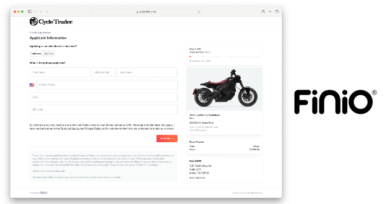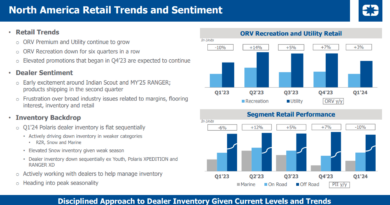Floorplan financing continues steady progression in Q1
GE Capital CDF seeing key indicators flat or positive
Sameer Gaur, president of the GE Capital Commercial Distribution Finance (CDF) motorsports group, recently provided Powersports Business with an update on the status of floorplan financing, and other key metrics involving inventory. The overall take is that floorplan financing for dealers appears to continue to be on a pace of steady improvement.
PSB: Looking at the first quarter of 2014, how would you assess the state of floorplan financing among powersports dealers compared to Q1 2013? Was there any drastic difference in those two periods?
Sameer Gaur: All-in-all, it feels more upbeat compared to the year-ago period. Our volume is up 11 percent in the U.S., which is an important indicator for us. That shows a combination of OEM confidence and dealer confidence, because the dealers are doing the ordering and the OEMs are doing the shipping. Outstandings are up, slightly more than the volume. Overall, things are
looking positive.
PSB: Based on that summation, what’s your assessment of the financial strength/outlook for the dealer body at large?
SG: We’re seeing the consumer starting to engage more in recreational activities. So it’s a healthy dealer body overall, which is what we’re seeing in other industries that CDF finances, including marine and RV. When you look at Q1, for snowmobile dealers, it was great. The weather helped the snow product line do well. Both Canada and the U.S. were up about almost 11 percent in retail sales in both regions. The last two winters did not allow snowmobile sales to go that deep, so this winter was important. It helped dealers go through a lot of inventory, which makes the next order cycle appear positive. There was sell-through on the snow product. It was nice to see inventories getting to a healthy low, and it’s good for the reordering cycle, which started March 31. That’s one aspect of the deep winter. The other aspect is it feels like spring is still to come. So we all handled a deep winter, and all powersports segments are either up or worst-case is flat. So the outlook is still strong.
PSB: How did turns look in the first quarter, compared to the year-ago quarter?
SG: Turns are just shy of 2.5, pretty much the same as Q1 of 2013. So turns remain in good shape, and aging (focusing on new model units older than 540 days) also remains in the same range, just around 5 percent, the same as Q1 2013. If I see volumes up, outstandings up, turns steady and aging tight, that’s a decent spot. We are pretty optimistic about it. Throw in what we’re seeing from an OEM product introduction standpoint in all product lines and across the price-point spectrum, which is also a very important health indicator, and yes, it feels pretty good. We’ve seen some nice introductions at the higher end of pricing and at the lower end. The snowmobile product turns helped the overall powersports turns get to flattish for the quarter, but as the spring season kicks off, those turns will likely improve.
PSB: In what ways are you seeing floorplan financing help dealers improve their inventory mix, and thus their potential to grow their bottom line?
SG: We consistently support the industry by onboarding more manufacturers. We added 10 in 2012 and another 10 in 2013, and we’ve added four so far this year in terms of new OEMs. It’s bringing more mix to the table. We do work with many manufacturers, so it makes it that much simpler for a dealer to source product from multiple customers that work with one provider and one system.
PSB: What have you seen in terms of demand and volume of pre-owned floor planning?
SG: It’s been consistent. It grew well for us last year and it’s growing well again this year, up about 30 percent in volume Q1 vs. Q1 2103, which includes auction, and up almost 50 percent in outstandings. If you look at the value proposition for our customer base, it’s important. Those pre-owned units offer higher margin, faster turns and makes the dealer healthier. As a stakeholder in the industry and being vested in its success, we want to help that kind of pull-through happen. It’s an important part of what we offer. We spent a good amount of time last year improving how our dealers apply for pre-owned lines on our online inventory manamement system COMS, so it’s a lot more user-friendly and seamless. We’ve simplified the process for the dealers and turnaround time is a lot faster in terms of getting funded. We also provide an auction line, which has gotten a lot of momentum.
PSB: What’s driving the auction floorplanning growth?
SG: The ease of doing business. We connect to the auction sites. From a dealer’s perspective, there’s a lot more you can do online, and ahead of the auction itself. There’s quite a bit of adoption online and it’s a good way for dealers to enhance their pre-owned inventory mix without having to wait for trade-ins.
PSB: GE Capital has talked a lot about the Middle Market in its partnership with the National Center for the Middle Market at Ohio State University. Will that continue to be an area of focus?
SG: The middle market (businesses between $10 million and $1 billion in revenue) is a segment of the market that’s really important as an engine, and it fits well with GE Capital, as that is who many of our customers are, across the business. The data from Q4 2013 shows that middle market companies grew revenue by 5 percent compared to Q4 2012, with the S&P 500 growing by 1 percent in that same time. That’s why it’s a very important segment of the American economy. Also, with respect to employment, 35 percent of middle market companies are saying that they’re adding employees. On the investment side, 64 percent of middle market companies say that they would spend money rather than hold on to it. That’s a return to levels last seen in Q2 2013, and it’s the highest level in the past five quarters.
PSB: What else is GE Capital doing to help its customers be successful?
SG: We want dealers and customers to be able to capitalize on our Access GE platform, which brings a number of sources and tools to build their business, ranging from healthcare reform issues to succession planning. We work with our customers on targeting growth and operational resources. We are and always want to be a much broader partner to our customers, both dealers and manufacturers. CDF is a stakeholder in the industry, whether it’s investing in the people or systems to make life easier for our customers.








